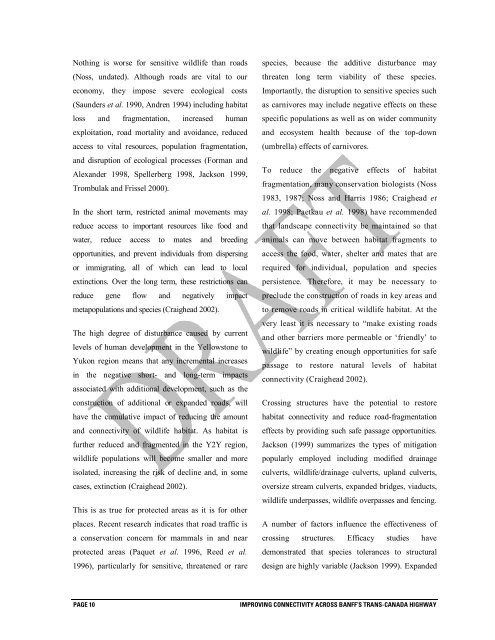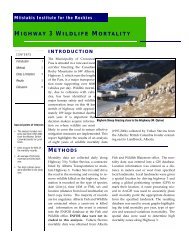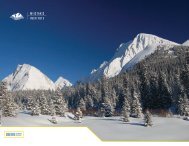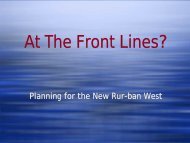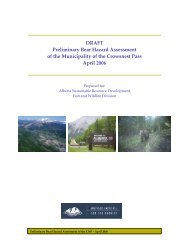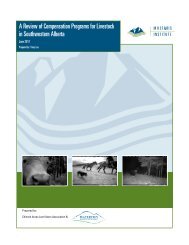A GIS based approach to restoring connectivity across Banff's Trans ...
A GIS based approach to restoring connectivity across Banff's Trans ...
A GIS based approach to restoring connectivity across Banff's Trans ...
Create successful ePaper yourself
Turn your PDF publications into a flip-book with our unique Google optimized e-Paper software.
Nothing is worse for sensitive wildlife than roads<br />
(Noss, undated). Although roads are vital <strong>to</strong> our<br />
economy, they impose severe ecological costs<br />
(Saunders et al. 1990, Andren 1994) including habitat<br />
loss and fragmentation, increased human<br />
exploitation, road mortality and avoidance, reduced<br />
access <strong>to</strong> vital resources, population fragmentation,<br />
and disruption of ecological processes (Forman and<br />
Alexander 1998, Spellerberg 1998, Jackson 1999,<br />
Trombulak and Frissel 2000).<br />
In the short term, restricted animal movements may<br />
reduce access <strong>to</strong> important resources like food and<br />
water, reduce access <strong>to</strong> mates and breeding<br />
opportunities, and prevent individuals from dispersing<br />
or immigrating, all of which can lead <strong>to</strong> local<br />
extinctions. Over the long term, these restrictions can<br />
reduce gene flow and negatively impact<br />
metapopulations and species (Craighead 2002).<br />
The high degree of disturbance caused by current<br />
levels of human development in the Yellows<strong>to</strong>ne <strong>to</strong><br />
Yukon region means that any incremental increases<br />
in the negative short- and long-term impacts<br />
associated with additional development, such as the<br />
construction of additional or expanded roads, will<br />
have the cumulative impact of reducing the amount<br />
and <strong>connectivity</strong> of wildlife habitat. As habitat is<br />
further reduced and fragmented in the Y2Y region,<br />
wildlife populations will become smaller and more<br />
isolated, increasing the risk of decline and, in some<br />
cases, extinction (Craighead 2002).<br />
This is as true for protected areas as it is for other<br />
places. Recent research indicates that road traffic is<br />
a conservation concern for mammals in and near<br />
protected areas (Paquet et al. 1996, Reed et al.<br />
1996), particularly for sensitive, threatened or rare<br />
species, because the additive disturbance may<br />
threaten long term viability of these species.<br />
Importantly, the disruption <strong>to</strong> sensitive species such<br />
as carnivores may include negative effects on these<br />
specific populations as well as on wider community<br />
and ecosystem health because of the <strong>to</strong>p-down<br />
(umbrella) effects of carnivores.<br />
To reduce the negative effects of habitat<br />
fragmentation, many conservation biologists (Noss<br />
1983, 1987; Noss and Harris 1986; Craighead et<br />
al. 1998; Paetkau et al. 1998) have recommended<br />
that landscape <strong>connectivity</strong> be maintained so that<br />
animals can move between habitat fragments <strong>to</strong><br />
access the food, water, shelter and mates that are<br />
required for individual, population and species<br />
persistence. Therefore, it may be necessary <strong>to</strong><br />
preclude the construction of roads in key areas and<br />
<strong>to</strong> remove roads in critical wildlife habitat. At the<br />
very least it is necessary <strong>to</strong> “make existing roads<br />
and other barriers more permeable or ‘friendly’ <strong>to</strong><br />
wildlife” by creating enough opportunities for safe<br />
passage <strong>to</strong> res<strong>to</strong>re natural levels of habitat<br />
<strong>connectivity</strong> (Craighead 2002).<br />
Crossing structures have the potential <strong>to</strong> res<strong>to</strong>re<br />
habitat <strong>connectivity</strong> and reduce road-fragmentation<br />
effects by providing such safe passage opportunities.<br />
Jackson (1999) summarizes the types of mitigation<br />
popularly employed including modified drainage<br />
culverts, wildlife/drainage culverts, upland culverts,<br />
oversize stream culverts, expanded bridges, viaducts,<br />
wildlife underpasses, wildlife overpasses and fencing.<br />
A number of fac<strong>to</strong>rs influence the effectiveness of<br />
crossing structures. Efficacy studies have<br />
demonstrated that species <strong>to</strong>lerances <strong>to</strong> structural<br />
design are highly variable (Jackson 1999). Expanded<br />
PAGE 10<br />
IMPROVING CONNECTIVITY ACROSS BANFF’S TRANS-CANADA HIGHWAY


